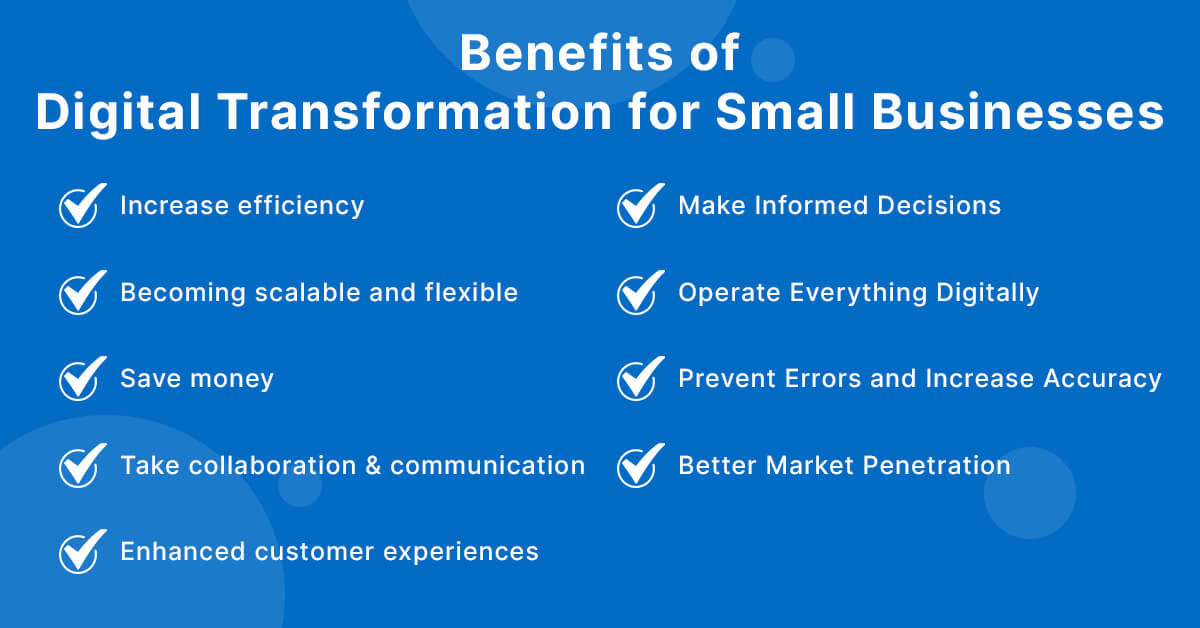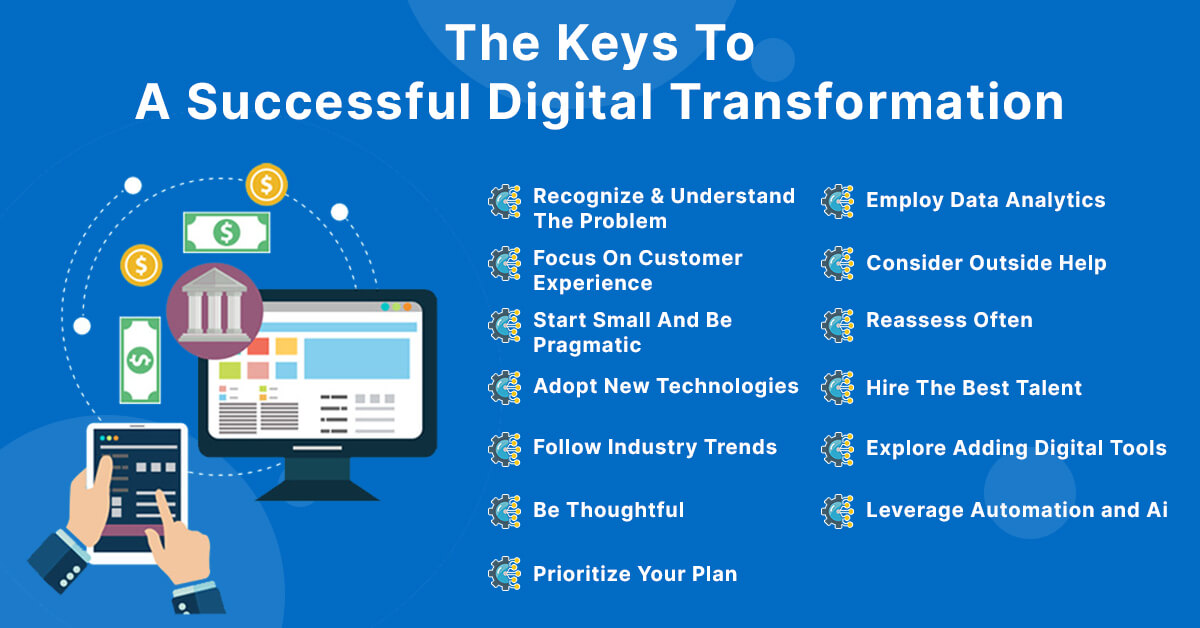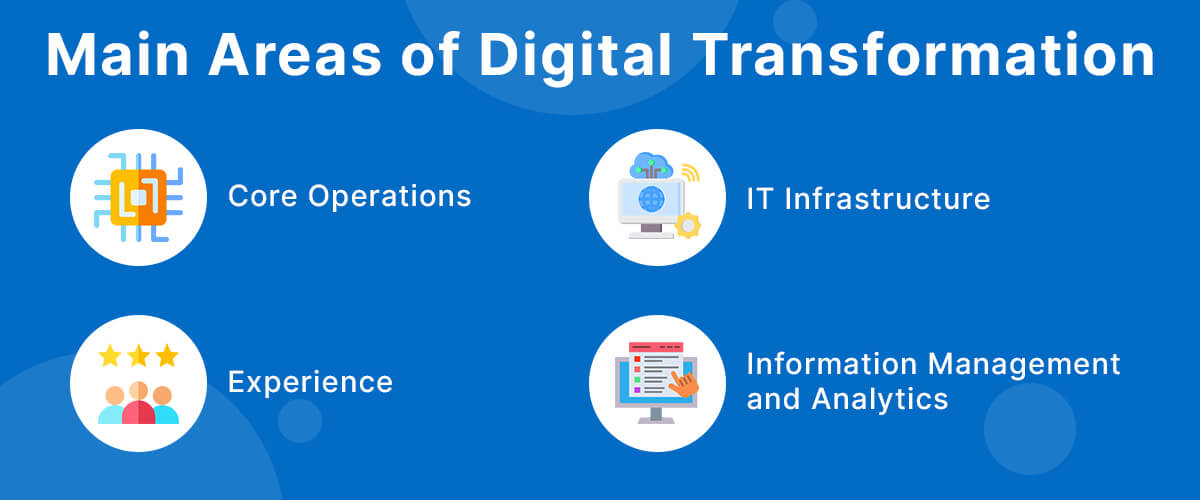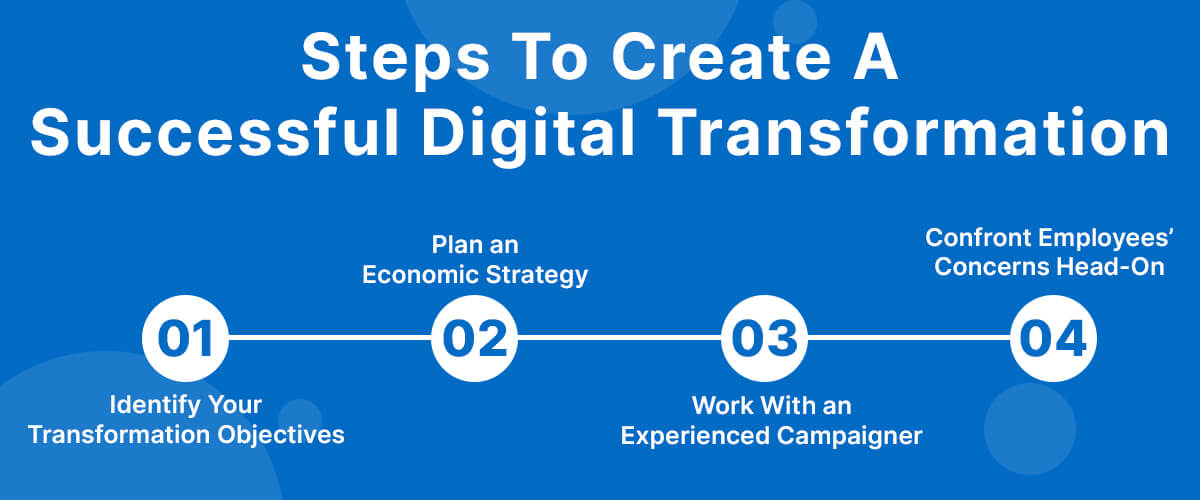
Research indicates that by 2025, global digital transformation technology expenditure is expected to reach an amazing $2.3 trillion. It notes how companies are seeing digital transformation as a long-term investment choice more and more. As a small business owner, you simply cannot afford to sit on the sidelines when companies all around are budgeting so much on digital transformation.
Digital transformation causes many small business owners great concern. They hold the belief that digitalization is not suitable for them. Conversely, digital transformation empowers small company owners to effectively compete with their larger rivals. Thanks in large part to the creative application of digital technologies, it helps them level the playing field.
Table of Contents
- What is digital transformation?
- Why do Small Businesses Need to Invest in Digital Transformation
- Digital Transformation Best Practices
- Recognize and understand the problem you are aiming to solve
- Focus on customer experience
- Start small and be pragmatic
- Adopt New Technologies
- Follow Industry Trends
- Be Thoughtful
- Prioritize Your Plan
- Employ Data Analytics
- Consider Outside Help
- Reassess Often
- Hire the Best Talent
- Explore Adding Digital Tools
- Leverage Automation and AI
- Digital Transformation Technologies and Services
- What are the four main areas of digital transformation?
- Steps for an Effective Digital Transformation
What is digital transformation?
The phrase “digital transformation” is somewhat common in the digital sphere. However, very few individuals truly understand the concept in its entirety. Everyone has unique ideas and perspectives, which reduces the efficiency of application.
Digital transformation involves more than just creating software, a website, or a mobile app, contrary to popular belief. Many believe that building competent software, a website, or a mobile app completes the job of digitalization. Digital transformation involves a fresh perspective on a traditional offline company.
The focus of digital transformation is on integrating digital technologies into a company’s core operations. Aligning the company with the digital customer’s needs will help it provide value.
Digital transformation is more of a cultural shift challenging conventional wisdom about corporate practices.
Key aspects of digital transformation include:
- The integration of digital technology across all aspects of a company transforms its operations and value delivery.
- By use of technologies including artificial intelligence, cloud computing, sophisticated analytics, and the Internet of Things, rethinking and redesigning business models, customer experiences, and internal operations is possible.
- We emphasize the need for constant adaptation and creativity, as digital transformation is a continuous process rather than a singular undertaking.
- Demand cultural transformation and a fresh leadership style since organizational agility as well as technological acceptance define success.
Why do Small Businesses Need to Invest in Digital Transformation
The issue then begs why, as the owner of a small firm, you should choose digital transformation. Let’s review some of the key factors that will help you decide to transition your company to a digital format.
-
Increase efficiency
Companies using digital tools and platforms will get real-time data access, analysis, and decision-making, therefore facilitating faster and more informed actions. Apart from that, automation of regular chores and procedures improves operations by lowering human mistakes and raising output. Furthermore, workers are engaged in creative projects rather than performing boring, repetitive chores, which enhances their efficiency and overall output.
-
Becoming scalable and flexible
Small companies that want to survive and grow have to quickly adjust to changing corporate needs and dynamics. Cloud-based solutions then provide small organizations with scalability to meet rising customer expectations and data needs.
-
Save money
By optimizing resource use and lowering paper waste, digital technology can save money and lessen environmental impact. Furthermore, automating chores and simplifying procedures can result in large financial savings. Both SaaS (Software as a Service) models and cloud computing commonly reduce IT infrastructure and maintenance expenses. This makes digital transformation a more affordable choice compared to traditional methods.
-
Take collaboration and communication to the next level
With video conferences or project management tools, most cloud-based systems let documents and data be shared in real time. Regardless of distance, digital tools help teams and partners to cooperate.
-
Enhanced customer experiences
For companies unable to afford to lose, consumers are valuable assets. Consumers search for services that are immediately available and very convenient; this is where multichannel communication solutions provide support. Small companies can personalize client interactions and offer customized services, advice, and assistance by means of digital transformation.
-
Make Informed Decisions Using Data-Driven Insights
The days of relying solely on intuition to make business decisions are long gone. Big data analytics today allows you to develop the data-driven decision-making process inside your small company. Before you commit to a given course of action in your company, data enables you to confirm it.
Data-driven decision-making finds applications in:
- Determine consumer needs by means of product and service reaction analysis for the corporate entity.
- Investigate any problems with a given good or service and also note possible fixes.
- Try the market for a brand-new good or service.
Data-driven decisions are for companies of all kinds. Only companies at the enterprise level earlier had access to advanced algorithms capable of analyzing data generated by other companies. But the volume of data created by humans exceeded all records as cellphones and other smart gadgets, including IoT sensors, became more common.
As data output grew, data analytics began to become more reasonably priced for startups. Any small firm today can access the wealth of information it generates and get significant insights from it at a far lower expense. More comprehensive SMB digital transformation makes sense given reduced expenses.
-
Operate Everything Digitally
Digital transformation lets a company run remotely. Closed for the day are banks? Not to worry; you can accept or pay for it online, which is always available 24 hours. There is no reason employees should show up for work. Let them work from home (WFH).
Whether your company is small or medium-sized, by converting your business operations to digital, you may automate duties such as staff management, manufacturing control, purchasing, supply chain, and logistics management. Once you automate daily chores, you can focus on strategic future planning for your company.
-
Prevent Errors and Increase Accuracy
The data supporting your choice will help you make a far more confident decision. Whether the decision is about releasing a new app or product, altering the appearance and feel of your website or app, or anything else, with data driving your decisions, the inclination of your choices becoming right will be much enhanced.
Data analytics helps your company follow the right path by improving the accuracy of your decision-making process, which alleviates any concerns you may have about the precision of your choices.
Data is concrete, a quality lacking in your gut feeling, so it is more dependable than your feelings. Eliminating subjective aspects of your company’s decisions will help build trust in your judgment. Data analytics serves you in this need.
Know that data analytics cannot be accurate without proper data. Great results cannot be expected if the data-collecting procedure is intrinsically faulty.
-
Better Market Penetration
Any firm depends on new clients as its lifeline. The first step in enabling your company to soar higher is converting your operations into digital form. Tools related to digital transformation are transforming our way of life and helping you to reach new clients across many countries.
Businesses have a lot of data at their disposal; thus, understanding the large volume of data will help guarantee that big data is very essential for corporate success. By means of digital transformation, your company will enter hitherto untapped markets and discover new consumers inside your current one.
More market penetration depends on correct market segmentation when you intend to launch new products into a certain market. Correct market segmentation made possible by digital transformation lets you target your good or service to the proper consumers. It can assist you in creating a devoted clientele by helping your customer conversion rate to be improved manifold.
Digital Transformation Best Practices
Digital transformation requires a well-defined strategy. Following best practices lets companies start their digital transformation projects right away, faster. These are the ideas to take into account while turning your company digital.
-
Recognize and understand the problem you are aiming to solve
Knowing ahead of time the digital transformative purpose and the problems it answers will help one. It enables data-driven decisions pertaining to tools and process leverage as well as a road map for digital transformation. Moreover, companies that have access to all the necessary data analysis will soon and effortlessly achieve digitalization.
-
Focus on customer experience
Small businesses driven by customer experiences invested time, money, and energy to implement digital projects and achieve digital transformation. Customers remain delighted, for example, when the company provides multichannel access—that is, when the activity initiated on one device is hassle-free on another device. By emphasizing this basic client need, companies can customize their digital strategy.
-
Start small and be pragmatic
Companies should not develop digital transformation plans based on technologies that require exceeding their budget. Rather, start with less and learn as the company grows; then, progressively improve digital strategy. Most digital channels are scalable, so you can assess which is best for you before diving in.
-
Adopt New Technologies
Already, big companies are experimenting with cutting-edge technologies, including artificial intelligence, the Internet of Things (IoT), and augmented reality. By starting with basic software and a small initial plan that can be enhanced later, the small firm can begin its operations from scratch. This strategy of implementing technology enables companies to remain ahead in the digital race and relevant.
-
Follow Industry Trends
Make sure digital transformation is a never-ending trip that continues with technological improvements rather than a destination. Keep up with the most recent tools and technology in specialized sectors to make sure digital transformation steps in with the changing user preferences and market trends.
-
Be Thoughtful
WWhen small businesses are ready to lead digital transformation, they must evaluate the changes needed in their digital strategy and identify any gaps. Using assessment instruments to involve every staff member in the evaluation will enable the organization to determine the current level of digitalization and identify areas for improvement compared to competing digital strategies.
The insightful information is worth considering the ideal digital solution with necessary components to eventually raise output. Showcase the value that digital transformation provides, including underlying costs, ROI, additional advantages, and other benefits, before proposing a digital agenda to staff members.
-
Prioritize Your Plan
The evaluation method exposes the issues that a lack of digital strategy is causing for businesses and how technology use addresses them. Businesses, for example, view AI-powered chatbots as means of enhancing customer support—a demand most of which comes from Give digital changes first priority and evaluate their impact one after the other.
-
Employ Data Analytics
Data analytics facilitates data-driven decision-making by helping to link the dots and compute insights from the various collections of data. Small companies can acquire the data gathered and computed from websites, social media, email, and others thanks to data analytics. Apart from data analysis, small businesses also learn about other facets of the customer journey, including devices used for purchasing, how customers interact with the company, and more. The valuable insights help companies contact users more effectively, thereby optimizing conversion rates.
-
Consider Outside Help
Key players need to spend a lot of effort in comprehending users’ digital paths and filling the hole, even if they have digital tools. If it overwhelms you, think about consulting an outside digital marketing agency that examines tools and data to ascertain the direction of digitalization and areas for development. Their knowledge and experience enable companies to raise the ROI and brand value.
-
Reassess Often
Your goal for digital transformation could have a reasonable return right now. However, without changing and upgrading the digitization plan, you cannot ensure long-term benefits. Adopting new technology to give the greatest experiences and solidify customer loyalty is crucial; hence, frequent reevaluation of digital transformation is necessary. Learn what works and what doesn’t from users’ and staff’s views on the change.
-
Hire the Best Talent
The correct team can make or destroy the project’s success. Screen the best talent before recruiting if you wish your company to flourish in the digital revolution. Since the availability of digital technologies won’t influence the project at all, you can either engage remote developers or in-house staff members. Hire talent according to the finest standards to get the best outcomes.
-
Explore Adding Digital Tools
Many digital technologies are now available to implement organizational change with technological advancement. Some instruments mislead the companies and won’t develop. Business will suffer greatly if such instruments are not thoroughly investigated before being implemented. Companies should thus give adequate time to carefully examine the features of selected digital tools. It guides their decisions on how they satisfy present wants and create something that is future-proof with flexibility to fit evolving needs.
-
Leverage Automation and AI
Digital transformation plans for small firms assist in identifying the operations that require automation and their priorities. Here, using artificial intelligence and automation enables wise completion of tasks.
Digital Transformation Technologies and Services
Digital transformation refers to various technologies and services designed to integrate digital capabilities into the operations and strategies of small firms, based on their specific aims and objectives. EEffective digital transformation typically involves the integration of various technologies and services to enhance creativity, efficiency, and competitiveness. It covers cloud computing, data analytics, artificial intelligence, the Internet of Things, and more. See which of these technologies support digital projects.
-
Digital experience platform
Deliver the correct content at the correct moment across the correct channel or device only if one has a greater awareness of the digital consumer experience. The digital experience platform then underpins digital marketing, content management, and commerce applications. Real-time personalizing, marketing automation, and omnichannel data gathering enable scaled digital transformation planning and execution.
-
Experience commerce
Experience commerce, sometimes known as “e-commerce,” is the digital channel for buying and selling products and services. It covers websites, mobile apps, online markets, and different online commerce solutions, allowing you to provide tailored purchasing experiences.
-
Content hub
A content hub is a consolidated platform or repository where SMBs may properly manage, arrange, and distribute material. It is fundamental for content production, storage, and diffusion among several media. TThe content hub serves as a centralized repository for managing digital assets, product content, marketing resources, and other elements related to the digital transformation project, which enhances collaboration among the digital marketing team in content development and management.
-
Cloud solutions
Infrastructure as a Service (IaaS), Platform as a Service (PaaS), and Software as a Service (SaaS) are among the several cloud-based offerings. Using scalable and reasonably priced solutions offered by cloud computing helps one to fully utilize digital marketing. Using the correct mix of marketing tools and cloud infrastructure, the plan is carried out fast at a lowered TCO.
-
Services, solutions, and consulting
Usually including a broad range of digital transformation-related services, solutions, and consulting advice. It covers advisory firms, technology companies, and solution providers that support companies in planning, executing, and optimizing digital projects.
What are the four main areas of digital transformation?
Usually comprising “four pillars,” which reflect the fundamental elements of an organization’s operations and strategy affected by digital technologies, digital transformation is The four primary elements of digital transformation that fit somewhat tightly are
-
Core operations
This subject covers changing the basic operations, methods, and business strategies of a company. Using digital technologies, daily activities like supply chain optimization, inventory control, labor management, and process automation—that is, streamlining and automating—are simplified and optimized. The objectives are to lower expenses, increase output, and raise efficiency.
-
Experience
The facet of digital transformation known as “experience” stresses improving the customer experience (CX) and occasionally the employee experience (EX). It crafts flawless, customized, and captivating interactions using digital tools and technologies. Creating user-friendly websites and mobile apps, using chatbots for customer service, customizing marketing initiatives, and enhancing online buying experiences, for instance, The employee experience might call for digital tools for training, remote work, and team building.
-
IT Infrastructure
Usually, digital transformation calls for updating or modernizing the IT systems of companies. It covers hardware, programs, networks, and cloud-based solutions as well. To guarantee their IT infrastructure is nimble, scalable, and sensitive to changing needs, small firms can shift to the cloud, embrace a microservices architecture, or apply DevOps techniques.
-
Information management and analytics
Digital transformation depends much on efficient data management and analytics. To support data-driven decision-making, data must be gathered, stored, analyzed, and then deduced from. To get a competitive edge and stimulate innovation, big data platforms, artificial intelligence and machine learning models for predictive analytics, and sophisticated data visualization are put in use.
Steps for an Effective Digital Transformation
You are thus all eager to use the advantages of digital transformation for your company. Let us now, then, explore the actions needed to successfully transition to a digital company.
-
Identify your Transformation objectives
Finding your transformation objectives will always be the first step towards your digital transformation process. Remember that we are trying to solve particular problems by means of digital transformation. Therefore, it is imperative to define the exact nature and degree of these difficulties.
First, you could have to review all of your company’s rules, procedures, and work practices to see whether they fit the digital style of business or not.
Having well-defined goals will help you to rapidly reach your target of digitalizing your company.
-
Plan an economic strategy
When choosing a digital transformation plan, small firms often make a serious error by overspending on cutting-edge solutions.
Getting that groundbreaking innovation in digital technology won’t cost you any major money. Recall that you run a little business; hence, you need to be careful with your money. If less expensive choices meet your needs, there is no harm in choosing them.
First, determine whether digital transformation would enable you to make the current procedures of your company less costly or not. Simple techniques like predictive analytics before advertising expenditure allow you to test the waters of digitalization before diving farther.
Cost-effective, and small business owners will find great use for a similar tool called CRM (Customer Relationship Management) software.
-
Work with an experienced campaigner
Some experts can assist you during the digital transformation process. Such top IT outsourcing firms will help simplify the process.
Look for a technology partner who has helped small businesses with their transition to a digital company.
It will not only greatly accelerate the process but also tax your mind significantly in terms of cognitive load. Realize that, although not a digital transformation specialist, you are an expert in your company.
You will be able to greatly simplify the process by contracting your digital transformation project to a qualified IT service provider.
Talk about your needs with your possible technology partners to develop a sensible digital transformation plan for your company that will support your path of development.
-
Confront employees concerns head-on
Digital transformation represents a significant change, and since people are generally resistant to change, any such transformation is likely to face some opposition. You have to inspire your staff members if you are to make your digital transformation plan effective. Talk to your staff straightforwardly about the reasons the company is using digital technology to modify its business plan.
Typically, employees fear losing their jobs or find the digital revolution in business challenging. Explain to them the benefits of Digital Transformation in their everyday operations and show them how it will enable them to boost their output, so winning their confidence.
Ensure that your staff members possess the necessary qualifications to adapt seamlessly.
-
Future is Digital
Small business owners are a sector that would gain more by embracing digitization; there is no business too small for digital transformation. If you decide to overlook changing your company to digital, know you will be swimming against the tide. The future is digital; hence, you do not want to be an analog participant in a digital environment.
Using experts in digital transformation can assist you to rapidly reach your target of digitally modernizing your business, so rendering it future-ready.
FAQs
1. What is digital transformation for small businesses?
Digital transformation for small businesses involves integrating digital technologies into all areas of the business to improve operations, enhance customer experiences, and drive growth. It often includes adopting tools like cloud software, automation, and e-commerce.
2. Why is digital transformation important for small businesses in 2025?
In 2025, digital transformation is essential for small businesses to stay competitive. It enables better customer engagement, streamlined operations, data-driven decision-making, and the ability to scale faster in an increasingly digital economy.
3. What are the first steps in starting digital transformation for a small business?
Start by identifying pain points and goals, then choose digital tools that align with your needs — such as cloud-based accounting, CRM software, or online sales platforms. Training staff and setting measurable KPIs are also crucial steps.
4. What are some examples of digital tools that help small businesses?
Popular digital tools include:
- Shopify for e-commerce
- QuickBooks for accounting
- HubSpot or Zoho CRM for customer management
- Slack or Microsoft Teams for communication
- Vitara.ai for building custom internal or customer-facing apps with AI
5. What are the biggest challenges small businesses face during digital transformation?
Common challenges include limited budgets, lack of technical expertise, resistance to change, and selecting the right tools. However, starting small and scaling gradually can help overcome these hurdles effectively.
 Gillian Harper
| May 16, 2025
Gillian Harper
| May 16, 2025
A professionally engaged blogger, an entertainer, dancer, tech critic, movie buff and a quick learner with an impressive personality! I work as a Senior Process Specialist at Topdevelopers.co as I can readily solve business problems by analyzing the overall process. I’m also good at building a better rapport with people!






